AUDI Q5 2017 Owners Manual
Manufacturer: AUDI, Model Year: 2017, Model line: Q5, Model: AUDI Q5 2017Pages: 296, PDF Size: 74.43 MB
Page 211 of 296
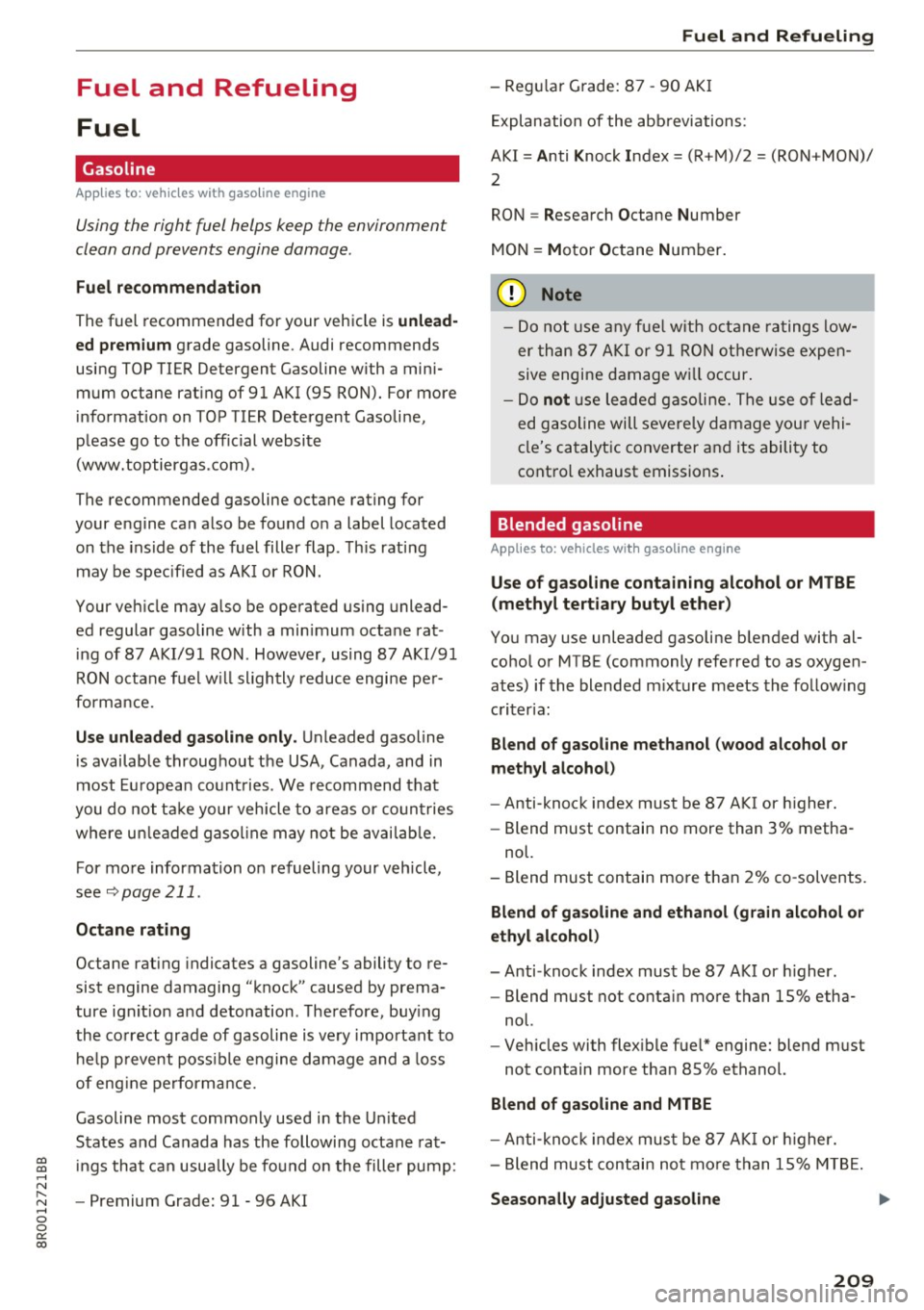
CD
CD
.... N ,-... N ..... 0 0 C<'. 00
Fuel and Refueling
Fuel
Gasoline
Applies to: vehicles with gaso line engine
Using the right fuel helps keep the environment
clean and prevents engine damage .
Fuel re co mm endati on
The fuel recommended for your vehicle is unlead
ed pr em ium
grade gasoline. Audi recommends
using TOP TIER Detergent Gasoline with a mini
mum octane rat ing of 91 AKI (95 RON). For more
information on TOP TIER Detergent Gasoline,
p lease go to the official website
(www.toptiergas .com) .
The recommended gasoline octane rating for
your engine can also be found on a label located
on the inside of the fuel filler flap . Th is rating
may be spec ified as AK I or RON.
Your veh icle may also be operated using unlead
ed regular gasoline with a min imum octane rat
ing of
87 AKl/9 1 RON . However, using 87 AKl/91
RON octane f uel w ill slightly reduce engine pe r
fo rmance.
Us e un lead ed g asolin e onl y. Unleaded gasoline
is available throughout t he USA, Canada, and in
most Eu ropean count ries . We recommend that
you do not ta ke your vehicle to areas or countries
where u nleaded gasol ine may not be availab le.
For more information on refueling your vehicle,
see
~ page 211.
Octane r ating
Octane rating indicates a gasoline's ability to re
sist engine damaging "knock" caused by prema
ture ignit ion a nd detonation . Therefore , buy ing
the co rrect grade of gasoline is very important to
h e lp p revent poss ible engine damage and a loss
of eng ine performance.
Gasoline most commonly used in the Un ited
States and Canada has the following octane rat
ings that can usually be fo und on the filler pump:
- Premium Grade: 91 -96 AKI
Fuel and R efueling
- Reg ular G rade: 87 -90 AK I
E xplanation of the abb reviations:
AK I=
Anti Knock Index = (R +M)/2 = (RON +MON)/
2
RON = Research Octane Number
MON = Motor Octane Number .
(D Note
-Do not use a ny fue l w it h octane ratings low
er than 8 7 AKI or 91 RON ot herwise expen
sive engine damage w ill occur .
- Do
not use leaded gasoli ne. The use of lead
ed gasoline will severe ly damage your vehi
cle's catalyt ic converter and its ability to
cont rol exhaust emissions .
Blended gasoline
Applies to: vehicles with gasoline engine
Use of gasoline containing alcohol or MTBE
(methyl tertiary butyl ether )
You may use unleaded gasoline blended with al
cohol or MTB E (commonly referred to as oxygen
ates) if the blended m ixture meets the follow ing
c riteria:
Blend o f gasoline methanol ( wood alcohol or
methyl alcoho l)
-Anti -knock index must be 87 AKI or h igher.
- Blend must contain no more than 3% metha-
nol.
- Blend must contain more than 2% co -solvents.
Blend of gasoline and ethanol (grain alcoh ol or
ethyl alcohol)
- Anti-knock index must be 87 AKI or higher .
- Blend must not conta in more than 15% etha-
nol.
- Veh icles with flex ible fue l* engine: blend must
not contain more tha n 85% ethanol.
Blend of gasoline and MTBE
- Anti-knoc k index mus t be 87 A KI or h igher.
- Blend must contain no t mo re than 15% MTBE.
S easonally adjusted ga soline .,,.
209
Page 212 of 296
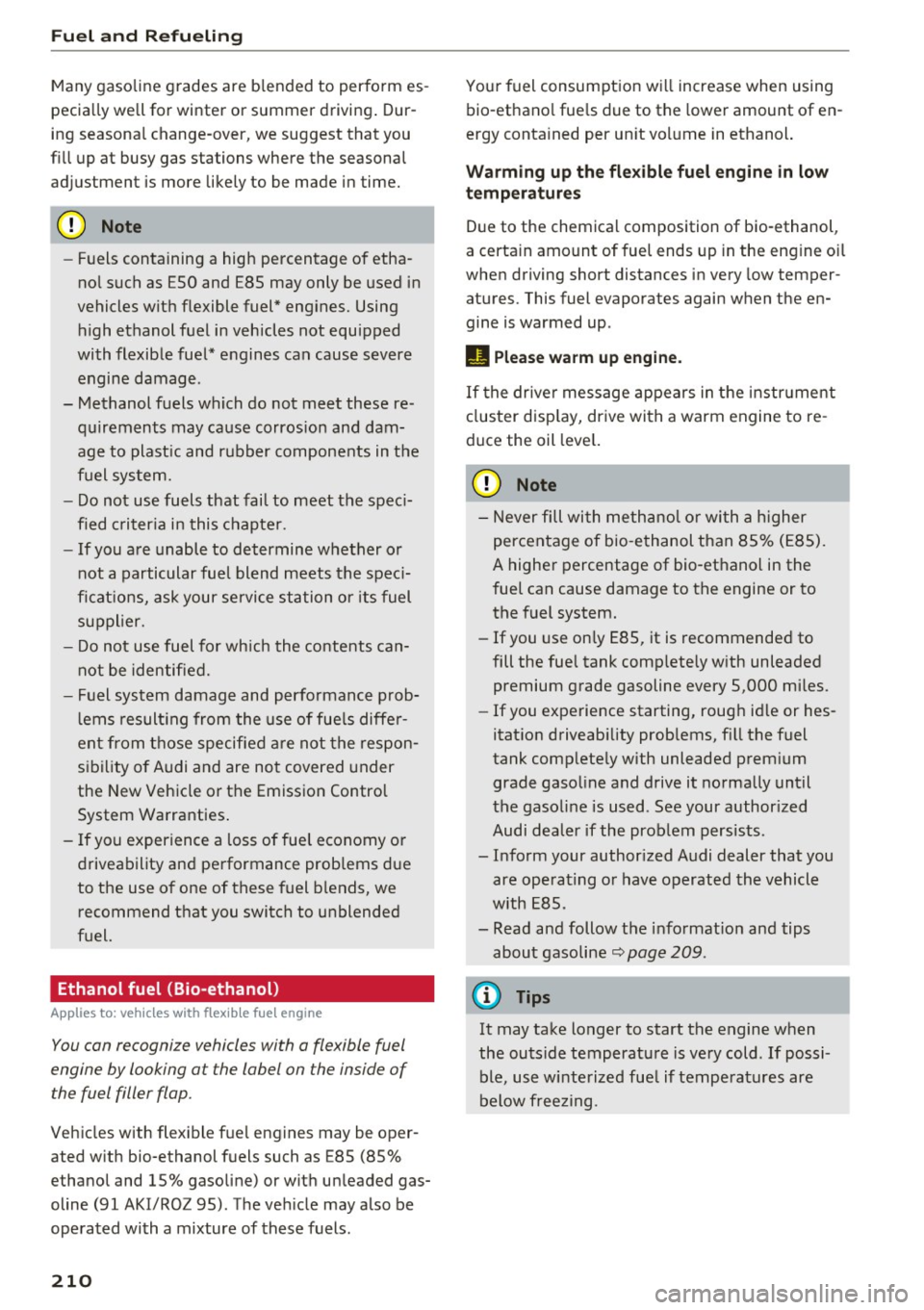
Fuel and R efu eli ng
Many gasoline grades are b lended to perform es
pecia lly we ll for winter or summer driving. Dur
ing seasonal change-over, we suggest that you
fill up at busy gas stations where the seasonal
adjustment is more likely to be made in time.
@) Note
-Fuels containing a high percentage of etha
nol such as ESO and E85 may only be used in
vehicles with flexible fuel* engines. Using high ethanol fuel in vehicles not equipped
with flexible fuel* engines can cause severe
engine damage.
- Methanol fuels which do not meet these re quirements may cause corros io n and dam
age to plast ic and rubber components in the
fuel system.
- Do not use fuels that fail to meet the spec i
fied c riter ia in this chapter.
- If you a re unable to determine whether or
not a particular fuel blend meets the spec i
ficat ions, ask your service station or its fuel
supplier.
- Do not use fuel for wh ich the contents can
not be identified.
- Fuel system damage and performance p rob
l ems result ing from the use of fue ls diffe r
ent from those specified are not the respon
s ibility of Audi and are not covered under
the New Vehicle or the Emission Control
System Warranties .
- If you experience a loss of fue l economy o r
driveability and performance prob lems due
to the use of one of these fuel b lends, we
recommend that you switch to unblended
fuel.
Ethanol fuel (Bio -ethanol)
Ap plies to: vehicl es w ith flex ible fuel engine
You con recognize vehicles with a flexible fuel
engine by looking at the label on the inside of
the fuel filler flop.
Vehicles with flexible f uel engines may be oper
ated w ith bio-ethanol fuels such as E85 (85%
ethanol and 15% gasoline) or with unleaded gas
oline (91 AKI/ROZ 95). The vehicle may also be
operated with a mixture of these fuels .
210
Your fuel consumpt ion wi ll increase when using
bio-ethano l fue ls due to the lower amount of en
ergy contained per un it vo lume in ethanol.
Warming up th e fle xible fuel engine in low
temperatures
Due to the chemical composition of bio-ethanol ,
a certain amount of fuel ends up in the engine o il
when driving short distances in very low temper
atures. This fuel evaporates again when the en
gine is warmed up .
II Please warm up engine .
If the driver message appears in the instr ument
cluster disp lay, drive with a warm engine to re
duce the oil leve l.
(D Note
- N ever fill with methano l o r with a h igher
percentage of bio -e thanol than 85% (E85).
A highe r percentage of bio-ethanol in the
fuel can cause damage to the engine or to
the fuel system.
- If you use on ly E85, it is recommended to
fill the fue l tank comp lete ly with unleaded
premium grade gasoline every 5,000 mi les.
- If you experience starting, rough id le or hes
itat ion driveab ility prob lems, f ill the fuel
tank comp lete ly with unleaded prem ium
grade gaso line and drive it no rma lly until
the gaso line is used. See your author ized
Audi dealer if the prob lem pers ists.
- Inform your authorized Audi dealer that you
are operat ing or have operated the vehicle
with E85.
- Read and follow the informat ion and tips
about gasoline~
page 209.
(D Tips
It may take longer to start the engine when
the outs ide temperature is ve ry cold . If possi
ble, use winterized fue l if tempe ratu res are
below free zing .
Page 213 of 296
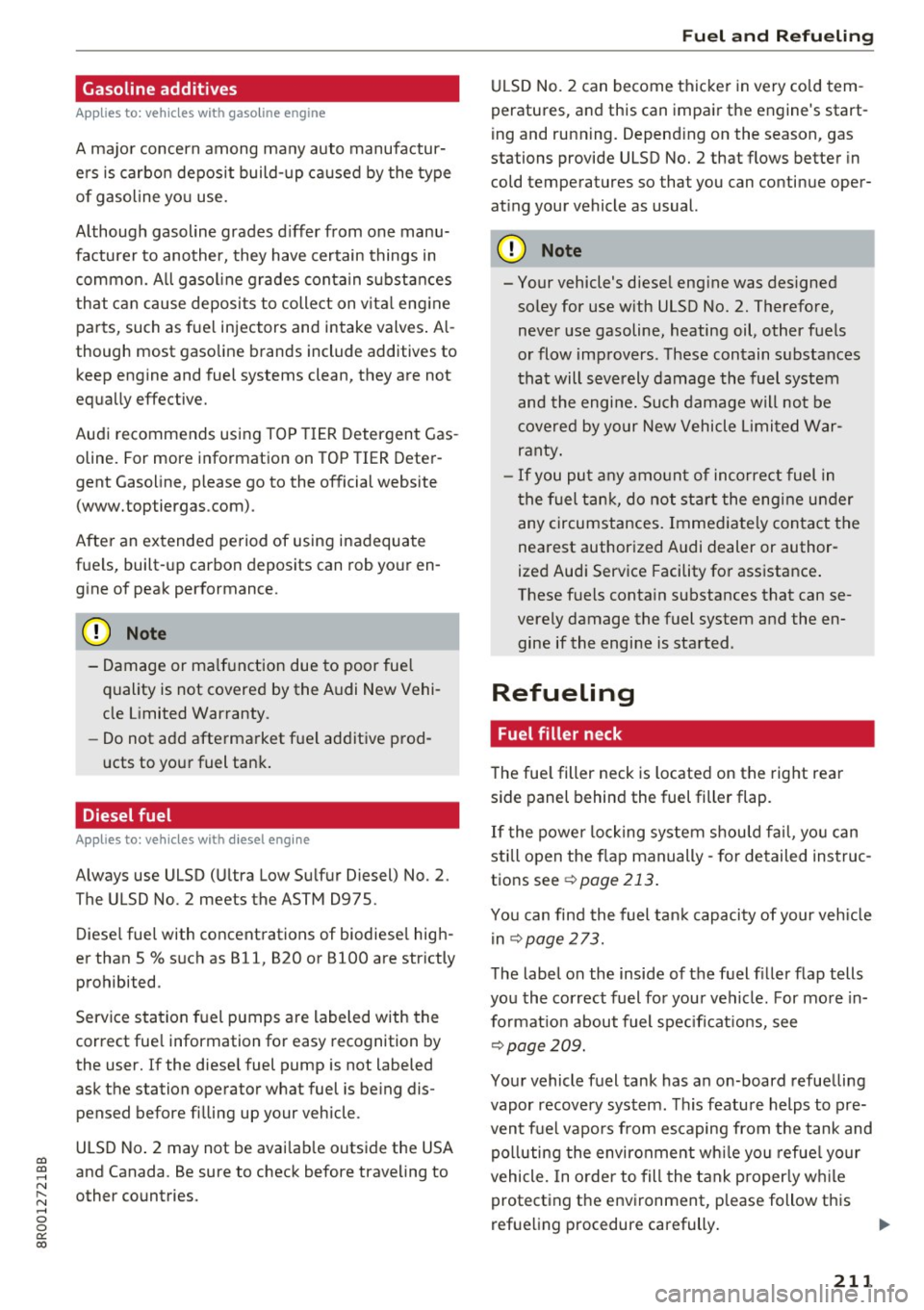
CD
CD
.... N ,-... N .... 0 0 C<'. 00
Gasoline additives
Applies to: vehicles with gasoline engine
A major concern among many auto manufactur
ers is carbon deposit build-up caused by the type
of gasoline you use.
Although gasoline grades differ from one manu
facturer to another, they have certain things in
common. All gasoline grades contain substances
that can cause deposits to collect on vital engine parts, such as fuel injectors and intake valves . Al
though most gasolin e brands include additives to
keep engine and fuel systems clean, they are not
equally effe ctive.
Audi recommends using TOP TIER Detergent Gas
oline. For more information on TOP TIER Deter
gent Gasoline , please go to the official website
(www.toptiergas.com).
After an extended period of using inadequate
fuels, built-up carbon depos its can rob your en
gine of peak performance.
CD Note
- Damage or malfunction due to poor fuel
quality is not covered by the Audi New Vehi
cle Limited Warranty .
- Do not add aftermarket fuel additive prod
ucts to your fuel tank.
Diesel fuel
Applies to: veh icles with diesel eng ine
Always use ULSD (Ultra Low Sulfur Diesel) No. 2.
The ULSD No . 2 meets the ASTM 0975.
Diesel fuel with concentrations of biodiesel high
er than S % such as 811,820 or 8100 are strictly prohibited.
Service station fuel pumps are labeled with the
correct fuel information for easy recognition by
the user. If the diesel fuel pump is not labeled
ask the station operator what fuel is being dis
pensed before filling up your vehicle .
ULSD No . 2 may not be available outside the USA
and Canada. Be sure to check before traveling to
other countries.
Fuel and Refueling
ULSD No. 2 can become thicker in very cold tem
peratures, and this can impair the engine 's start
ing and running. Depending on the season, gas
stations provide ULSD No.
2 that flows better in
cold temperatures so tha t you can continue oper
ating your vehicle as usual.
CD Note
- Your vehicle's diesel engine was designed
soley for use with ULSD No.
2. Therefore,
never use gasoline, heating oil, other fuels
or flow improvers . These contain substances
that will severely damage the fuel system
and the engine. Such damage will not be
covered by your New Vehicle Limited War
ranty.
- If you put any amount of incorrect fuel in
the fuel tank, do not start the engine under
any circumstances. Immediately contact the
nearest authorized Audi dealer or author
ized Audi Service Facility for assistance.
These fuels contain substances that can se
verely damage the fuel system and the en gine if the engine is started .
Refueling
Fuel filler neck
The fuel filler neck is located on the right rear
side panel behind the fuel filler flap.
If the power locking system should fail, you can
still open the flap manually -for detailed instruc
tions see
¢ page 213.
You can find the fuel tank capacity of your vehicle
in
¢ page 273.
The label on the inside of the fuel filler flap tells
you the correct fuel for your vehicle. For more in
format ion about fuel specificat ions, see
¢ page 209.
Your vehicle fuel tank has an on-board refuelling
vapor recovery system. This feature helps to pre
vent fuel vapors from escaping from the tank and polluting the environment while you refuel your
vehicle. In order to fill the tank properly while
protecting the environment, please follow this
refueling procedure carefully.
211
Page 214 of 296
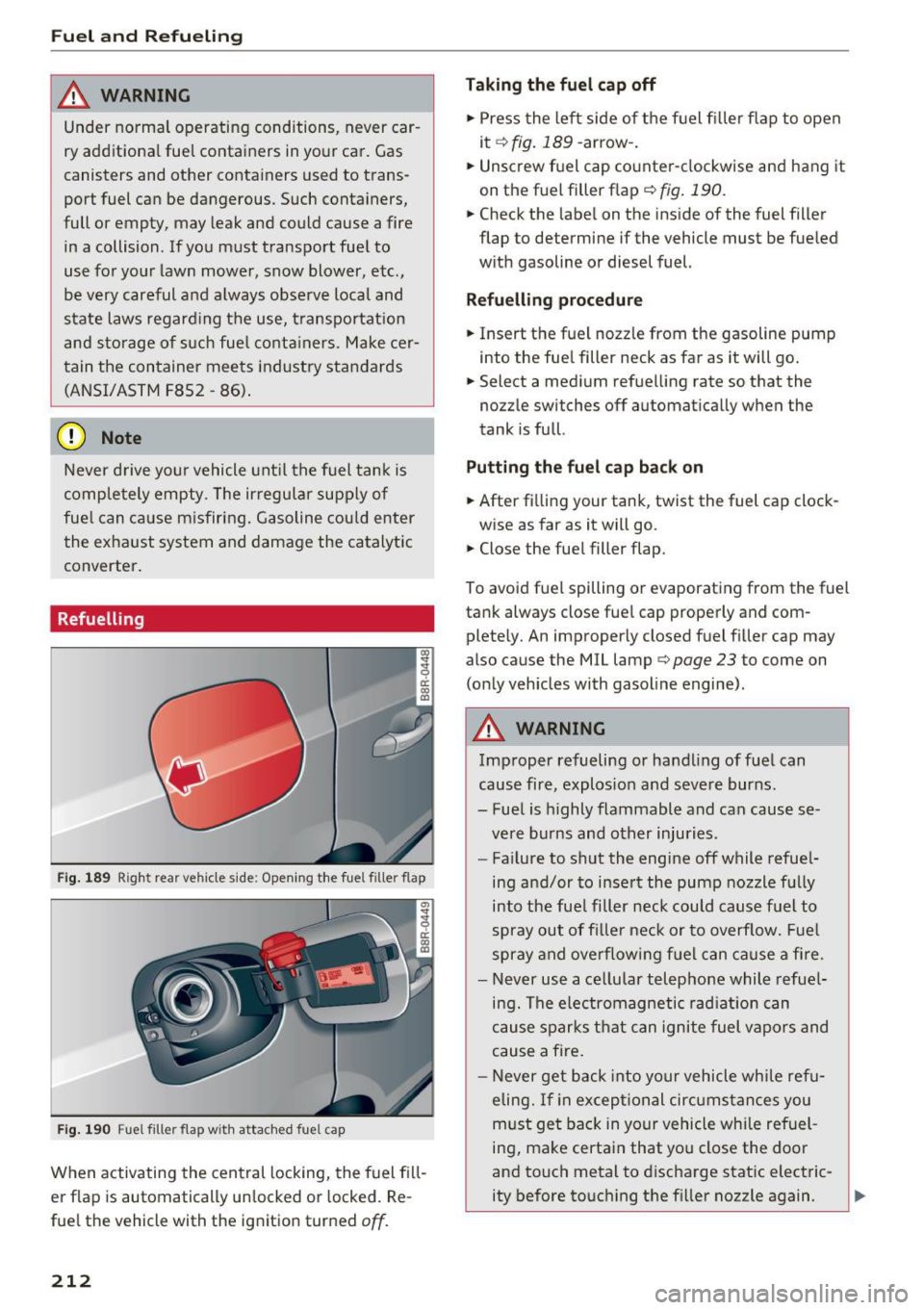
Fuel and R efue li ng
_& WARNING
Under normal operating conditions, never car
ry additional fuel containers in you r car. Gas
canisters and other containers used to trans
port fuel can be dangerous . Such containers,
full or empty, may leak and could cause a fire
in a collision. If you must transport fuel to
use for your lawn mower, snow blower, etc.,
be very careful and a lways observe local and
state laws regarding the use, transportation
and sto rage of such fue l conta iners. Make cer
tain the container meets industry standards (ANSI/ASTM F852 -86) .
(D Note
Never drive you r vehicle unt il the fuel tank is
comp letely empty. The irregular supply of
fue l can cause m isfiring. Gasoline cou ld enter
the exhaust system and damage the catalytic
converter.
Refuelling
Fig. 189 Right rear veh icle side: Opening the fuel filler flap
Fig. 190 Fuel filler flap wit h attac hed fuel cap
When activating the central locking, the fuel f ill
er flap is automatically unlocked o r locked. Re
fuel the vehicle with the ignition turned
off.
212
Taking th e fue l cap off
.. Press the left side of the fuel fi ller flap to open
it
¢ fig. 189 -ar row-.
.. Unscrew fuel cap counter-clockwise and hang it
on the fuel filler flap¢
fig. 190 .
.. Check the label on the inside of the fuel filler
flap to determine if the vehicle must be fueled
w ith gasoline or diesel fuel.
Refuelling procedur e
.. Insert the fuel nozzle from the gasoline pump
into the fuel filler neck as far as it will go.
.. Select a medium refuelling rate so that the
nozzle switches off automatically when the
tank is full.
Putting th e fu el c ap b ack o n
.. After filling your tank, twist the fuel cap clock-
wise as far as it will go.
.. Close the fuel filler flap.
To avoid fuel spilling or evaporating from the fuel
tank always close fuel cap properly and com
plete ly. An improperly closed fuel filler cap may
also cause the MIL lamp¢
page 23 to come on
(only vehicles with gasoline engine).
_& WARNING
Improper refueling or handling of fuel can
cause fire, explos ion and severe burns.
- Fuel is highly flammable and can cause se
vere burns and other injuries.
-
- Fa ilure to shut the engine off while refuel
ing and/or to insert the pump nozzle fully into the fue l filler neck could cause fuel to
spray out of fi ller neck or to overflow. Fue l
spray and ove rflowing f uel can ca use a fire .
- Never use a ce llular telephone while refuel
ing. The electromagnetic radiation can
cause sparks t hat can ignite fuel vapors and
cause a fire.
- Never get back into your vehicle whi le refu
eling. If in exceptional circumstances you
must get back in your vehicle wh ile refuel
ing, make certain that you close the door
and touch metal to discharge static electric-
ity before touching t he f iller nozzle again. .,_
Page 215 of 296
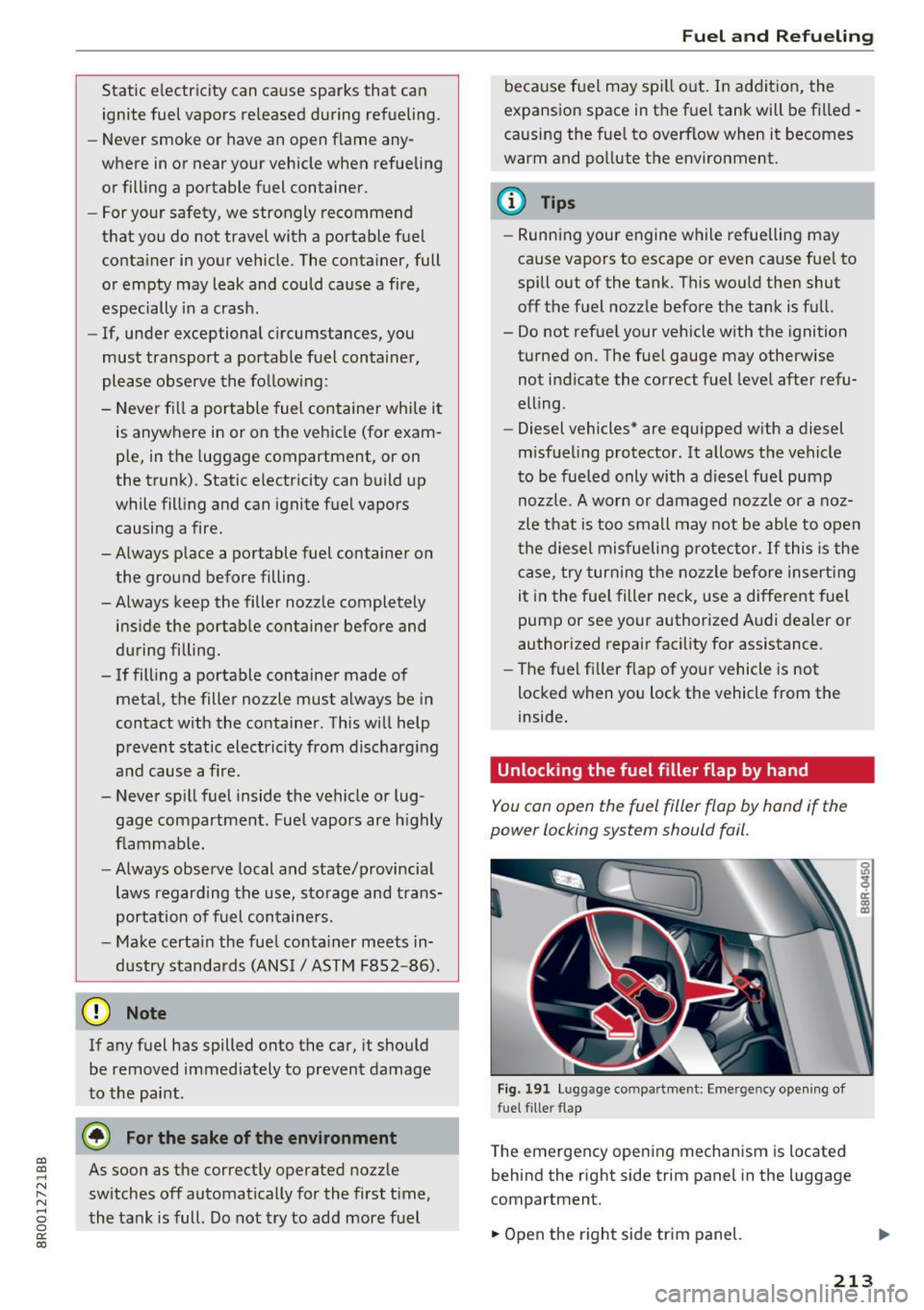
a,
a,
..... N ,-... N ..... 0 0
0:
co
Static electricity can cause sparks that can ignite fuel vapors released during refueling.
- Never smoke or have an open flame any
where in or near your vehicle when refueling or filling a portable fuel container.
- For your safety, we strongly recommend
that you do not travel with a portable fuel
container in your vehicle. The container, full
or empty may leak and could cause a fire,
especially in a crash.
- If, under exceptional circumstances, you
must transport a portable fuel container,
please observe the follow ing :
- Never fill a portable fuel container while it
is anywhere in or on the vehicle (for exam
ple, in the luggage compartment, or on
the trunk) . Static electricity can build up
while filling and can ignite fuel vapors causing a fire .
- Always p lace a portable fuel container on
the ground before filling.
- Always keep the filler nozzle completely
ins ide the portable container before and
during filling.
- If filling a portable container made of
metal, the filler nozzle must always be in
contact with the container . This will help
prevent static electric ity from discharg ing
and cause a fire .
- Never spill fuel inside the vehicle or lug
gage compartment . Fuel vapors are h ighly
flammab le.
-Always observe local and state/provincial
laws regarding the use, storage and trans
portation of fuel containers.
- Make certa in the fuel co nta iner meets in
dustry standards (ANSI/ ASTM F852 -86) .
(D Note
If any fuel has spilled onto the car, it should
be removed immediately to prevent damage
to the paint .
@ For the sake of the environment
As soon as the correctly operated nozzle sw itches off automatically for the first time,
the tank is full. Do not try to add more fuel
Fuel and Refueling
because fuel may spill out. In addition, the
expansion space in the fuel tank will be filled -
causing the fue l to overflow when it becomes
warm and pollute the environment.
@ Tips
- Running your engine while refuelling may
cause vapors to escape or even cause fuel to
spill out of the tank. This would then shut
off the fuel nozzle before the tank is full.
- Do not refuel your vehicle with the ignition
turned on. The fuel gauge may otherwise not indicate the correct fuel level after refu
elling .
- Diesel vehicles* are equipped with a diesel
m isfueling protector . It allows the vehicle
to be fueled only with a diesel fuel pump
nozzle. A worn or damaged nozzle or a noz
zle that is too small may not be able to open
the diesel misfueling protector.
If this is the
case, try turning the nozzle before inserting
it in the fuel filler neck, use a different fuel
pump or see your authorized Audi dealer or
authorized repair facility for assistance.
- The fuel filler flap of your vehicle is not
locked when you lock the vehicle from the
inside.
Unlocking the fuel filler flap
by hand
You can open the fuel filler flap by hand if the
power locking system should fail.
Fig. 191 Lu ggage compa rtmen t: E merge ncy opening of
fu e t fitte r flap
The emergency opening mechanism is located
behind the right side trim panel in the luggage
compartment.
.. Open the right side trim panel.
213
Page 216 of 296
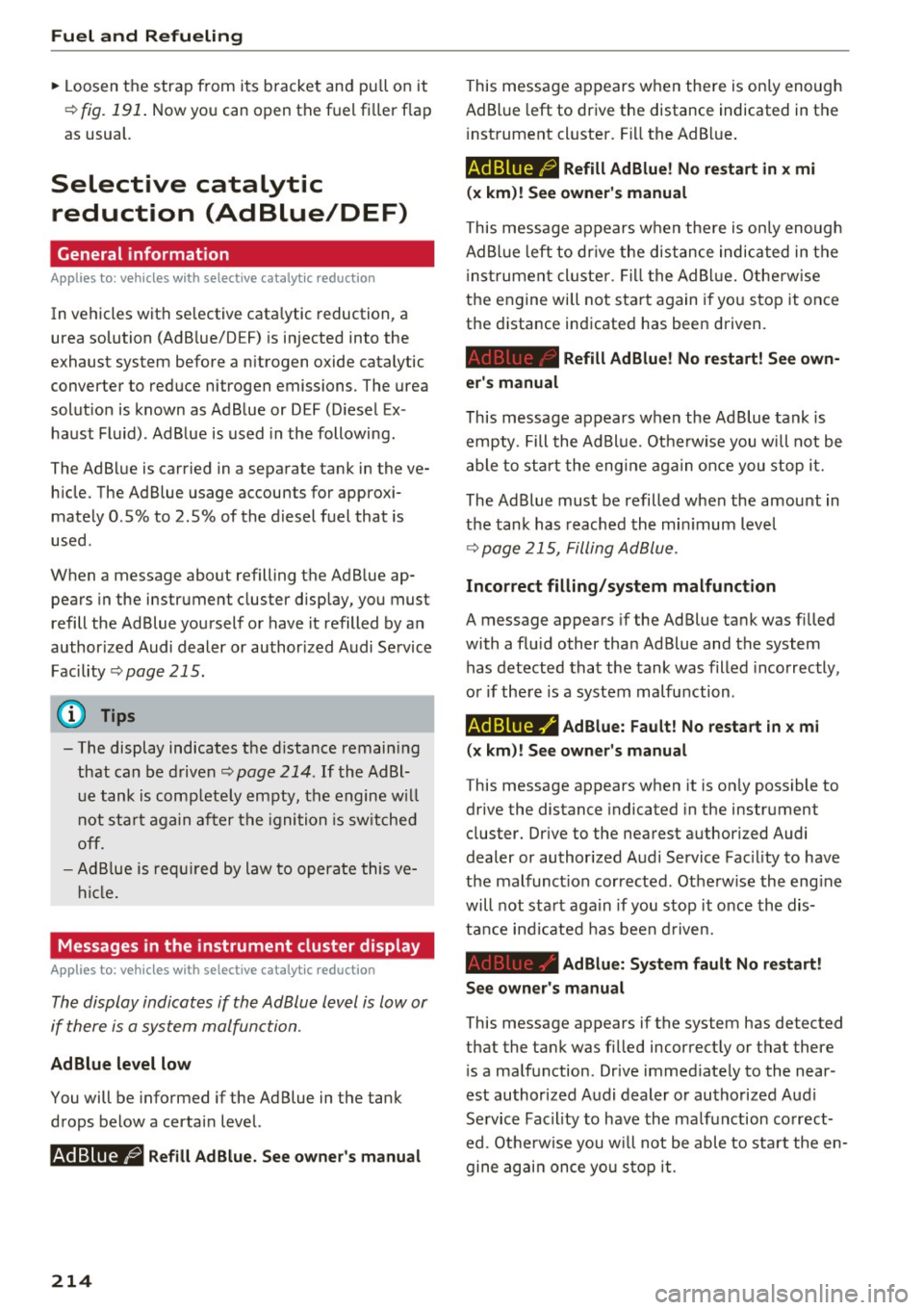
Fuel and Refueling
"'Loosen the strap from its bracket and pu ll on it
¢
fig. 191 . Now you can open the fuel filler flap
as usual.
Selective catalytic reduction (AdBlue/DEF)
General information
Applies to: veh icles w ith selective catalyt ic reduction
In vehicles with selective catalytic reduction, a
urea solution (Ad B lue/DEF) is injected into the
exhaust system before a nitrogen oxide catalytic
converter to reduce nitrogen emissions. The urea
solution is known as Ad Blue or DEF (Diesel Ex
haust Fluid) . AdBlue is used in the following.
The AdBlue is carried in a separate tank in the ve
hicle. The Ad Blue usage accounts for approxi mately 0 .5% to 2.5% of the diesel fuel that is
used.
When a message about refilling the Ad Blue ap
pears in the instrument cluster display, you must
refill the Ad Blue yourself or have it refilled by an
authorized Audi dealer or authorized Audi Service
Facility ¢ page 215.
(D} Tips
-The display indicates the distance remaining
that can be driven¢
page 214. If the Ad Bl
ue tank is completely empty, the engine will
not start again after the ignition is switched
off.
-Ad Blue is required by law to operate this ve
hicle.
Messages in the instrument cluster display
Applies to: vehicles with selective catalytic reduction
The display indicates if the Ad Blue level is low or
if there is a system malfunction.
AdBlue level low
You will be informed if the Ad Blue in the tank
drops below a certain level.
Ad Blue /9 Refill Ad Blue. See owner's manual
214
This message appears when there is only enough
Ad Blue left to drive the distance indicated in the
i nstrument cluster. Fill the Ad Blue.
AdBlue /9 Refill Ad Blue! No restart in x mi
(x km)! See owner's manual
This message appears when there is only enough
Ad Blue left to dr ive the distance indicated in the
i nst rument cluster. Fill the Ad Blue. Otherw ise
the engine will not start again if you stop it once
the distance indicated has been driven.
Refill Ad Blue! No restart! See own
er's manual
This message appears when the Ad Blue tank is
empty . Fill the Ad Blue. Otherwise you will not be
able to start the engine again once you stop it.
The Ad Blue must be refilled when the amount in
the tank has reached the minimum leve l
¢ page 215, Filling AdBlue .
Incorrect filling/system malfunction
A message appears if the Ad Blue tank was filled
with a flu id other than Ad Blue and the system
has detected that the tank was filled incorrectly,
or if there is a system malfunction .
Ad Blue -I' AdBlue: Fault! No restart in x mi
(x km)! See owner's manual
This message appears when it is on ly possible to
drive the distance indicated in the instrument
cluster. Drive to the nearest authorized Audi
dealer or authorized Audi Service Facility to have
the malfunct ion corrected. Otherw ise the eng ine
will not start again if you stop it once the dis
tance indicated has been driven.
AdBlue: System fault No restart!
See owner's manual
This message appears if the system has detected
that the tank was filled incorrectly or that there
is a malfunction . Drive immediately to the near
est authorized Audi dealer or authorized Audi
Service Facility to have the malfunction correct
ed . Otherwise you will not be able to star t the en
gine again once you stop it.
Page 217 of 296
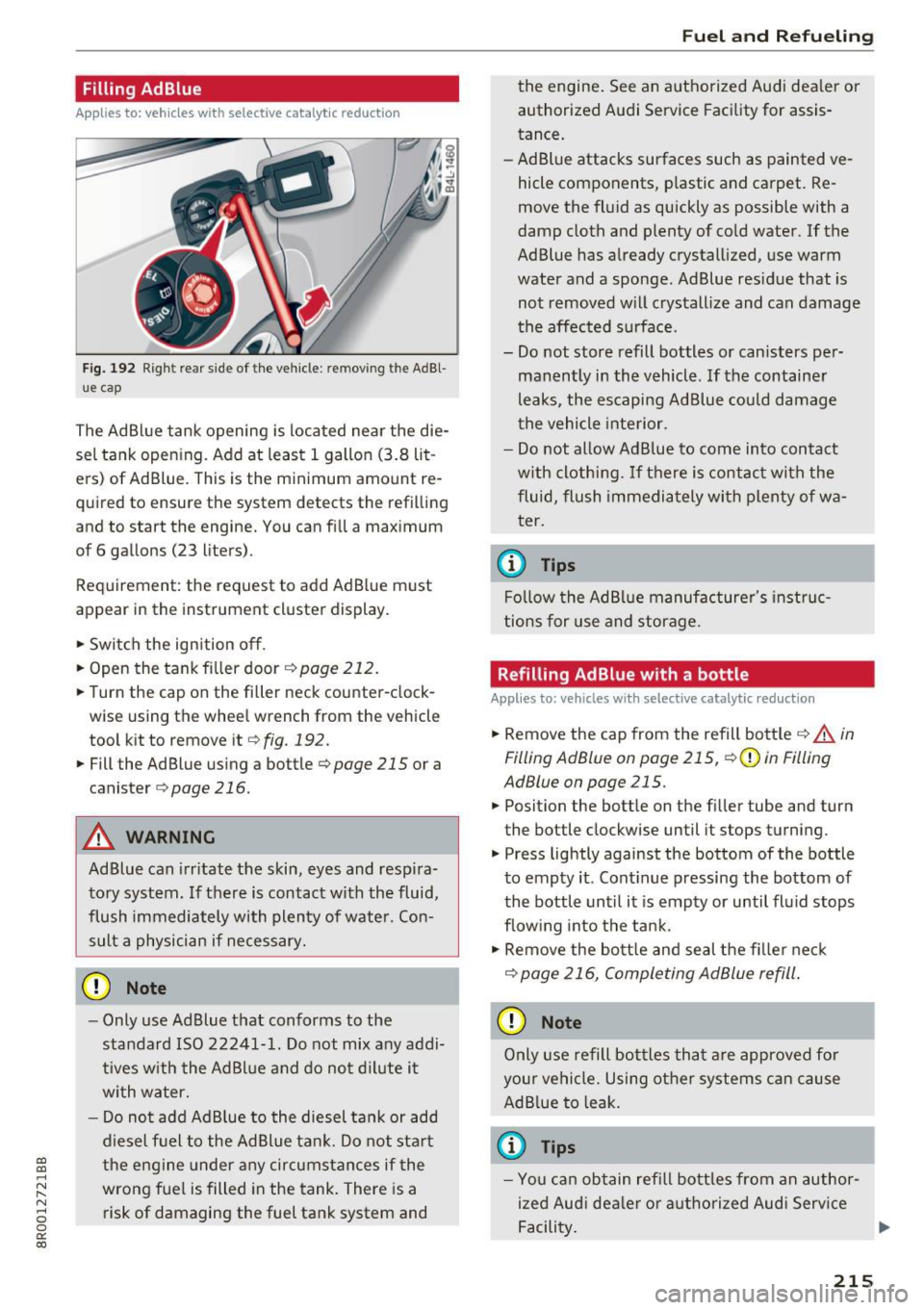
a,
a,
..... N r-N ..... 0 0
0:
co
Filling AdBlue
Applies to: vehicles with selective catalytic reduction
Fig. 192 Right rear side of the vehicle : remov ing the AdBl
ue cap
The Ad Blue tank opening is located nea r the die
sel tank open ing. Add at least 1 gallon (3.8 lit
e rs) of Ad Blue. This is the minimum amount re
quired to ensure the system detects the refilling
and to start the engine. You can fill a maximum
of 6 gallons (23 liters) .
Requirement: the request to add Ad Blue must
appear in the instrument cluster display.
• Switch the ignition off.
• Open the tank fi ller door ¢
page 212.
• Turn the cap on the filler neck counter-clock
wise using the whee l wrench from the vehicle
tool kit to remove it¢
fig . 192.
• Fill the Ad Blue using a bottle¢ page 215 or a
canister
c> page 216.
A WARNING
Ad Blue can irr itate the skin, eyes and resp ira
tory system. If there is contact with the fluid,
flush immediately with plen ty of wate r. Con
sult a physician if necessary.
CD Note
- Only use Ad Blue that conforms to the
standard ISO 22241-1. Do not mix any addi
tives w ith the Ad Blue and do not d ilute it
with water.
- Do not add Ad B lue to the diesel tank or add
diesel fuel to the Ad Blue tank. Do not start
the engine under any circumstances if the
wrong fuel is filled in the tank. There is a
risk of damaging the fuel tank system and
Fue l an d Re fuelin g
the engine . See an authorized Audi dea ler or
authorized Audi Service Facility for assis
tance.
- Ad Blue attacks surfaces such as painted ve
hicle components, p lastic and carpet. Re
move the fluid as quickly as possible with a
damp cloth and plenty of cold water . If the
Ad Blue has already crystallized, use warm
water and a sponge. Ad Blue residue that is not removed w ill crystallize and can damage
the affected surface.
- Do not store refill bottles or canisters per
manently in the vehicle . If the container
leaks, the escaping Ad Blue could damage
the vehicle interior.
- Do not al low Ad Blue to come into contact
w ith clothing.
If there is contact with the
fluid, flush immediately with plenty of wa
ter.
© Tips
Fo llow the AdBl ue manufacturer's instruc
tions for use and storage.
Refilling AdBlue with a bottle
Applies to: vehicles wit h selective catalytic reduction
• Remove the cap from the refill bott le ¢ A in
Filling AdBlue on page 215,
c> (D in Filling
AdBlue on page 215.
• Position the bottle on the filler tube and turn
the bottle clockwise until it stops turning.
• Press lightly against the bottom of the bottle
to empty it . Cont inue pressing the bottom of
the bottle until it is empty or until fluid stops
f low ing into the tank.
• Remove the bott le and seal the f iller neck
¢ page 216, Completing AdBlue refill .
CD Note
Only use refill bottles that are approved for
your vehicle. Using other systems can cause AdB lue to leak.
(0 Tips
- You can obtain refill bo ttles from an author
ized Aud i dea le r or authorized Audi Serv ice
Facility.
215
Page 218 of 296
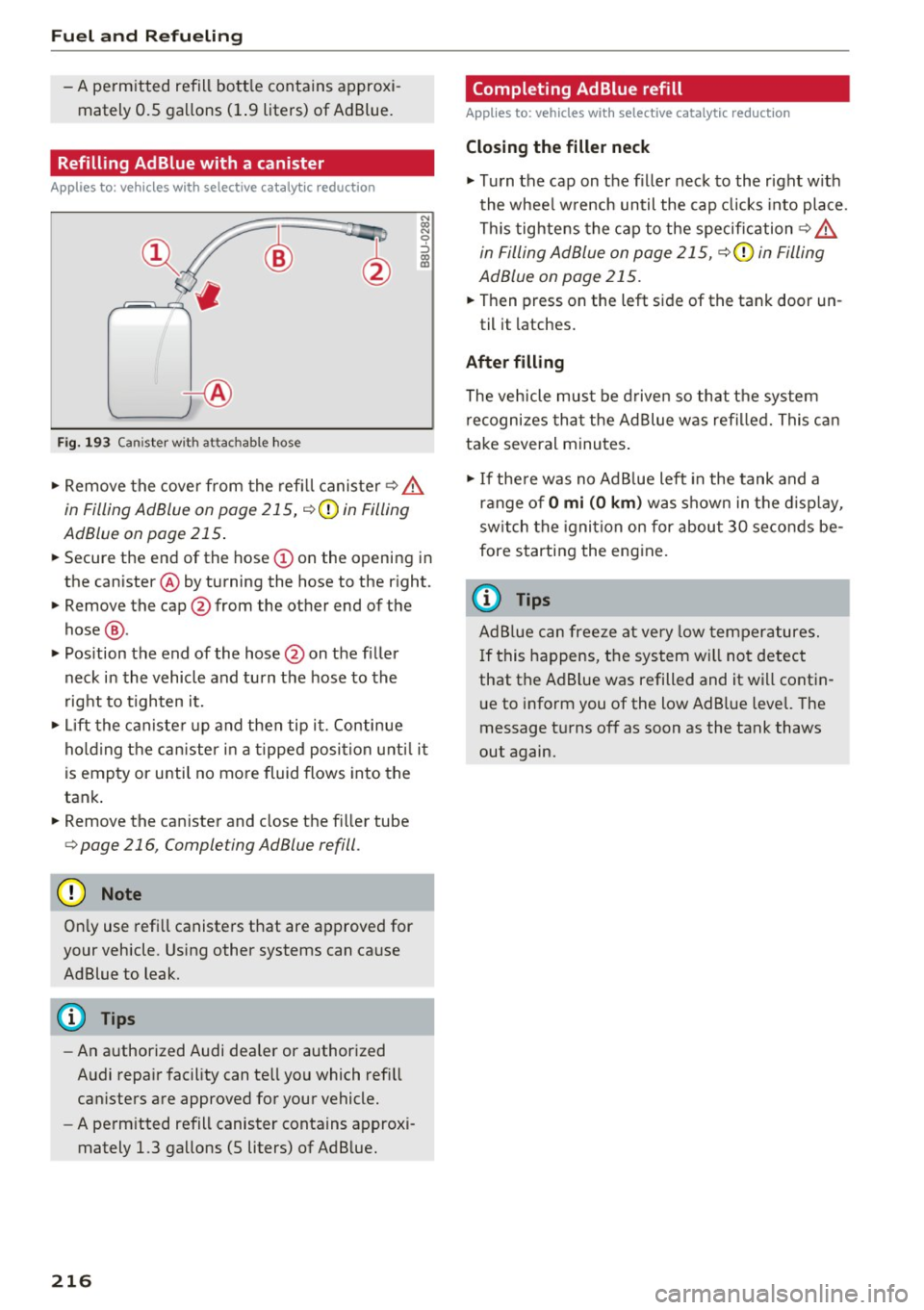
Fuel and Refueling
-A permitted refill bott le contains approxi
mately 0 .5 gallons (1.9 liters) of Ad Blue.
Refilling Ad Blue with a canister
A ppl ies to: ve hicles w ith select ive ca talyt ic reduction
®
+®
F ig. 193 Canister wit h attac hab le hose
N
~ 0 :::, a:, m
.., Remove the cover from the refill canister~ A
in Filling AdBlue on page 215, c>(D in Filling
AdBlue on page 215 .
... Secure the end of the hose (Don the opening in
the canister @ by turning the hose to the right.
... Remove the cap @from the other end of the
hose @.
"' Pos ition the end of the hose@ on the f iller
neck in the vehicle and turn the hose to the
right to tighten it.
.., Lift the canister up and then tip it. Continue
holding the can ister in a tipped position unti l it
is empty or until no mo re fluid flows into the
tank .
... Remove the canister and close the fi ller tube
c> page 216 , Completing AdBlue refill .
(D Note
Only use refill canisters that are approved for
your vehicle. Using other systems can cause
Ad Blue to leak.
@ Tips
- An authorized Audi dealer or authorized
Audi repair facility can tell you which refill
can isters are approved for your vehicle.
- A permitted refill canister contains approxi
mately 1.3 gallons (5 liters) of Ad B lue.
216
· Completing AdBlue refill
App lies to : vehicles with selective cata lyt ic re du ction
Closing the filler neck
... Turn the cap on the filler neck to the right w ith
the wheel w rench until the cap clicks into place .
This tightens the cap to the specification ~
A
in Filling AdBlue on page 215, c>(D in Filling
AdBlue on page 215 .
... Then press on the left side of the tank door un-
til it latches.
After filling
The vehicle must be driven so that the system
recognizes that the Ad Blue was refilled. This can
take several minutes .
.., If there was no AdB lue left in the tank and a
range of
O mi (0 km ) was shown in the display,
sw itch the ignition on for about 30 seconds be
fore starting the engine .
(D Tips
Ad Blue can freeze at very low temperatures.
If this happens, the system will not detect
that the Ad B lue was refilled and it will contin
ue to inform you of the low Ad Blue level. The
message turns off as soon as the tank thaws
out again.
Page 219 of 296

Checking and Filling Hood
Releasing the engine hood
The engine hood is released from inside the vehi
cle .
Fig. 194 Drive r's side footwell: e ng ine hood re lease lever
"' Wi th the driver's door open, pu ll th e leve r un
der the instrument panel in the direction of the
arrow ¢fig.194 .
The hood pops up s light ly unde r spri ng p ressure.
Opening the engine hood
Fi g. 19 5 Release lever under t he eng ine hood
Before opening the engine hood, make sure tha t
the w indshield wipe rs are fla t against the w ind
shie ld. Otherwise, they could d amage t he paint
on the hood .
"' Pull up on the release under the hood
~fig . 195. Th is releases the cat ch.
"' Open the hood all the way¢&,, .
a,
~ ,&. WARNING
r--
~ Hot engine coo lant can burn you. 0 0
0:
co
Checking and Filling
- To reduce the r isk of being burned, never
open the hood if you see or hear steam or
coo lant escaping from the engine compart
ment. Wa it until no steam or coolant can be
seen or hea rd before carefully ope ning t he
hood.
Closing the engine hood
"' Pull the hood down until the press ure from the
s truts is red uced.
"' Le t the hood
drop down and latch in p lace. Do
not try to push it shut ;
it may fail to engage
¢ &,, .
A WARNING
- -
A hood that is not completely latched co uld
f ly up and block your view while dr iv ing.
- When you close the engine hood, c heck it to
make sure the safety catch has prope rly en
gaged . The hood should be flush with the
sur rounding vehicle body parts .
- If you notice while driv ing that the hood is
not secured prope rly , stop at once and close
it .
Working in the engine compartment
Be especially careful whenever you work in the
engine compartment.
Whenever you must pe rfo rm any work in the
eng ine compa rtment , for e xample check ing and
fill ing diffe rent fluids, the re is a ris k of injury,
burns and acciden ts. To pre vent personal injur y
always ob serve the fo llowing WARNINGS . The
eng ine compartment of any vehicle is a hazard
ou s area
~ .&, .
A WARNING
To he lp avoid injury, befo re yo u check any
t h ing u nder the hood:
- Tur n off the engine.
- Remove the ig nitio n key .
- Apply the parking brake.
-
- Move selector lever of automatic t ransm is-
sion to P (Park).
217
Page 220 of 296
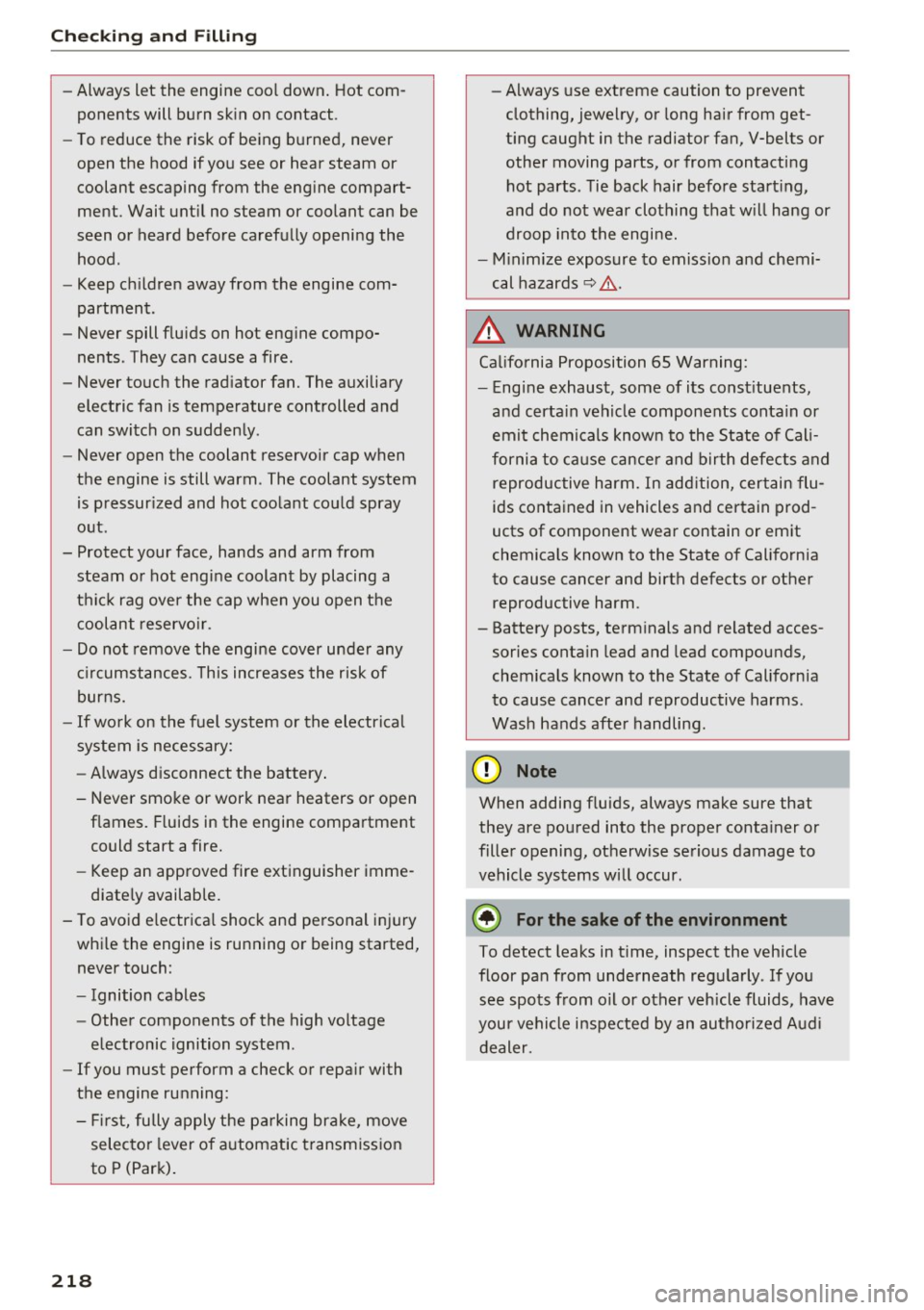
Checking and Filling
-Always let the engine cool down. Hot com
ponents will burn skin on contact .
- To reduce the risk of being burned, never
open the hood if you see or hear steam or
coolant escaping from the engine compart
ment. Wait until no steam or coolant can be
seen or heard before carefully opening the
hood.
- Keep children away from the engine com
partment.
- Never spill fluids on hot engine compo
nents . They can cause a fire.
- Never touch the radiator fan. The auxiliary
electric fan is temperature controlled and
can switch on suddenly.
- Never open the coolant reservoir cap when
the engine is still warm. The coolant system
is pressurized and hot coolant could spray
out .
- Protect your face, hands and arm from steam or hot engine coolant by placing a
thick rag over the cap when you open the coolant reservoir.
- Do not remove the engine cover under any
circumstances . This increases the risk of
burns.
- If work on the fuel system or the electrical
system is necessary:
- Always disconnect the battery.
- Never smoke or work near heaters or open flames. Fluids in the engine compartment
could start a fire.
- Keep an approved fire extinguisher imme
diately available.
- To avoid electrical shock and personal injury
while the engine is running or being started, never touch:
- Ignition cables
- Other components of the high voltage
electronic ignition system .
- If you must perform a check or repair with
the engine running:
- First, fully apply the parking brake, move
selector lever of automatic transmission
to P (Park).
218
- Always use extreme caution to prevent
clothing, jewelry, or long hair from get
ting caught in the radiator fan, V-belts or
other moving parts, or from contacting hot parts . Tie back hair before starting,
and do not wear clothing that will hang or
droop into the engine.
- Minimize exposure to emission and chemi
cal hazards
~ &.
&, WARNING
California Proposition 65 Warning:
- Engine exhaust, some of its constituents,
and certain vehicle components contain or
emit chemicals known to the State of Cali
fornia to cause cancer and birth defects and
reproductive harm. In addition, certain flu
ids contained in vehicles and certain prod
ucts of component wear contain or em it
chemicals known to the State of California
to cause cancer and birth defects or other
reproductive harm .
- Battery posts, terminals and related acces sories contain lead and lead compounds,
chemicals known to the State of California
to cause cancer and reproductive harms .
Wash hands after handling.
('.!) Note
When adding fluids, always make sure that
they are poured into the proper container or
filler opening, otherwise serious damage to
vehicle systems will occur.
@ For the sake of the environment
To detect leaks in time, inspect the vehicle
floor pan from underneath regularly . If you
see spots from oil or other vehicle fluids, have
your vehicle inspected by an authorized Audi dealer.